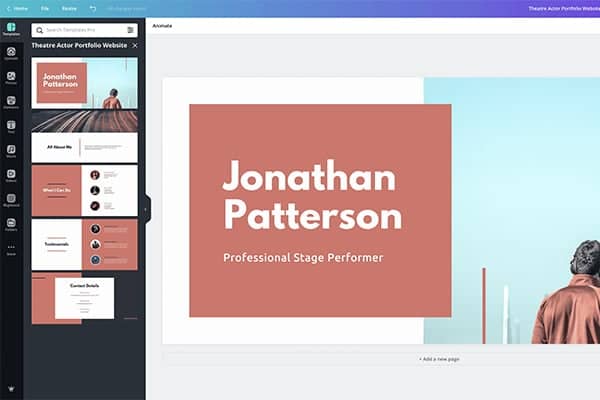The Ultimate Overview to Modern Website Style Trends
In the ever-evolving digital landscape, modern-day site layout patterns play a vital function in forming individual experience and interaction. From the surge of minimal design principles that focus on simpleness to the effect of bold typography in specifying brand identification, each element contributes to a cohesive on the internet presence.
Minimalist Layout Concepts
Minimalist layout principles highlight the idea that less is a lot more, supporting for simplicity and functionality in visual communication. This method strips away unneeded aspects, focusing instead on crucial elements that communicate the designated message efficiently. By focusing on clearness, minimal layout boosts individual experience, enabling site visitors to navigate websites effortlessly.
Core tenets of minimal style consist of the usage of enough white space, which creates a feeling of balance and company. This unfavorable room not only guides the customer's focus to crucial elements but additionally cultivates a calming visual atmosphere. In addition, a limited shade palette is typically employed, making use of soft tones or single schemes to preserve aesthetic cohesion and avoid frustrating the customer.
Typography plays a vital function in minimalist style, where understandable font styles are chosen for their simpleness and performance in interacting content. Ultimately, minimal layout principles grow a concentrated atmosphere that encourages users to engage with the web content, enhancing the general performance of modern-day internet site style.
Bold Typography Choices
Accepting bold typography choices has come to be a defining attribute of contemporary website design, as it efficiently records interest and communicates solid messaging. Developers are progressively making use of typography not merely as a useful element yet as an essential aesthetic component that improves the total aesthetic and individual experience.

Furthermore, the juxtaposition of bold typography with minimal style concepts permits for striking contrasts, enhancing readability while keeping aesthetic allure. Making use of whitespace around bold text even more stresses its value, ensuring that the message resonates with the target market.
As digital landscapes end up being extra affordable, leveraging bold typography makes it possible for brands to differentiate themselves and leave a long-term impression. The careful choice of font styles and their application can evoke emotions, develop tone, and drive activity, making bold typography an essential tool in contemporary internet site design. Inevitably, it is an effective way to boost narration and ensure that essential messages are not just seen yet also felt.
Mobile-first and receptive Design
Responsive and mobile-first design has become a vital concept in contemporary website growth, reflecting the boosting dependence on mobile gadgets for accessing on-line material. As user behavior shifts towards mobile surfing, developers need to prioritize developing experiences that adapt effortlessly throughout different screen sizes and resolutions.
A receptive design guarantees that a site instantly adjusts its design, images, and functionality based upon the gadget being made use of. This approach enhances customer experience by offering consistent navigation and readability, irrespective of whether the site visitor gets on a mobile phone, desktop computer, or tablet computer. In addition, mobile-first design advocates for creating web sites at first for smaller screens, ultimately scaling approximately bigger display screens. This approach urges redirected here an extra reliable and structured design procedure, concentrating on important content and functionality first.
Executing responsive and mobile-first concepts not only deals with customer preferences yet likewise lines up with search engine optimization (SEARCH ENGINE OPTIMIZATION) practices. Significant search engines, like Google, prioritize mobile-friendly internet sites in their positions, making it crucial for businesses to adopt these style strategies. In an affordable digital landscape, accepting receptive and mobile-first style is not simply an option; it is necessary for guaranteeing access and engagement with a diverse audience.
Engaging Microinteractions
Microinteractions play an essential duty in improving individual involvement and total internet site experience, particularly in the context of responsive and mobile-first layout. These subtle design components supply prompt responses to users, making communications more satisfying and instinctive. Instances consist of button animations, notification signals, and filling indications, which not only guide users but likewise develop a feeling of link with the interface.
Integrating appealing microinteractions can substantially enhance functionality by minimizing cognitive lots. When users receive visual or acoustic feedback upon carrying out actions, such as clicking a button or submitting a type, they really feel a lot more confident in their options. This promotes a smoother navigation experience, inevitably enhancing user retention.

As site style trends remain to advance, the importance of microinteractions can not be overemphasized. They work as the subtle yet powerful touchpoints that change normal communications into amazing experiences, thus boosting the general effectiveness of modern-day web layout.
Lasting Web Style Practices
Sustainable internet layout techniques are coming to be progressively vital as the electronic landscape grows and environmental problems climb. Designers and developers are acknowledging their responsibility to develop web sites that not just offer individual needs yet also lessen ecological influence. This method encompasses numerous essential techniques.
First of all, best site optimizing energy intake is vital. Sites ought to be made to fill rapidly and successfully, which minimizes web server energy usage and boosts customer experience. Techniques such as image compression, reducing HTTP requests, and making use of modern-day coding methods contribute significantly to this objective.
Secondly, selecting green hosting carriers is essential - website design. Several holding firms are now powered by sustainable energy resources, enabling web sites to run in an extra sustainable way. This selection mirrors a commitment to minimizing carbon impacts
Additionally, embracing a minimal layout can enhance sustainability. Less elements on a page bring about less information transfer, which not just quickens packing times yet additionally preserves sources.
Lastly, promoting digital ease of access ensures that sites get to a larger audience without unneeded bloat, lining up customer experience with Resources environmental duty. By incorporating these lasting practices, internet developers can add favorably to both individual interaction and the world's wellness.
Final Thought
In summary, modern site layout patterns highlight the integration of minimalist concepts, strong typography, and receptive layout to improve customer experience. Embracing these trends is vital for creating impactful electronic experiences that resonate with individuals in an increasingly affordable on the internet landscape.
In the ever-evolving electronic landscape, modern-day site design trends play an essential duty in forming user experience and involvement. By prioritizing quality, minimal style boosts individual experience, enabling visitors to browse websites effortlessly.
Eventually, minimal design concepts grow a focused setting that encourages customers to involve with the content, improving the general efficiency of modern-day web site layout.Microinteractions play a critical function in improving customer interaction and total internet site experience, particularly in the context of receptive and mobile-first design.In recap, modern website style trends highlight the assimilation of minimal concepts, strong typography, and receptive layout to improve user experience.